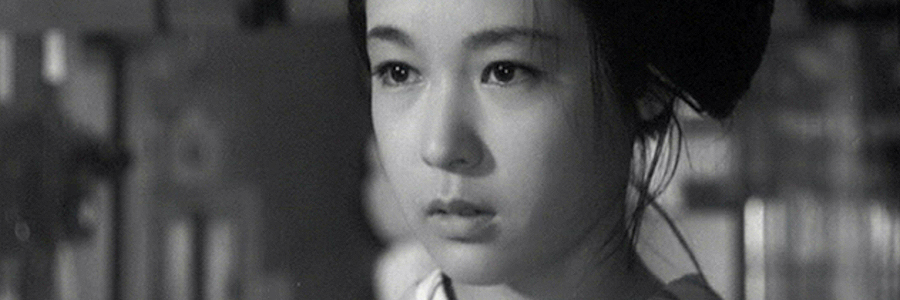
A Geisha

A GEISHA (MOVIE)
Daiei
Original release: August 12th, 1953
Running time: 85 minutes
Country of origin: Japan
Original language: Japanese
Director: Kenji Mizoguchi
Writer: Yoshikata Yoda
Cast: Michiyo Kogure, Ayako Wakao

The years following WWII in Japan were fascinating not just in the history of that country; this era has much to offer for sociologists, economists and art lovers by any historical measure. The sweeping changes within a unique culture that was struggling to come to terms with losing the war and with the devastation left in its wake tells us about the human condition in many ways. So if you’re a film lover and Japan-ophile like me, you’ll want to watch out for films that were made during this time as they directly address post-war life in Japan.
Kenji Mizoguchi’s film A Geisha does that, but it shows post-war struggles from a perspective that perhaps makes it even more insightful and fascinating: the mysterious and controversial world of Japan’s famous female entertainers, the geisha. The approach is almost asking to be taken; how will this ultra-conservative and highly ritualistic tradition adapt to the rapidly changing world around it? As film critic Tadao Sato noted, there are similarities between this film and Mizoguchi’s earlier Sisters Of The Gion:

While there are similarities in the character dynamic between older and younger geisha, this post-war film has much more relatable leads and I would disagree with Sato’s description of the period being “more accommodating”. This is most apparent when the young Eiko (Ayako Wakao), who had recently become a “maiko” (apprentice geisha), enquires about the new constitution, which moved the formerly militaristic Japan to becoming a more democratic system under the allied occupation following the war. Although this west-inspired constitution granted citizens fundamental human rights, Eiko is confronted by a number sceptical geisha when she tries to find out what she can legally do to keep herself out of harm’s way. The new rules have been put in place, but society can only change gradually and the film shows that this is especially true for the traditional world of geisha.
Therefore what we really see in A Geisha is a world where individuals can see the prospect of a better future while still being dragged down by an ever-so-persistent past. With the economic hardship of the time, Eiko is out of options and the film begins with her begging Miyoharu (Michiyo Kogure), an established geisha, to take her as apprentice. After the death of her mother, Eiko’s uncle attempted to gain sexual services from her, so training to be a geisha is the only way Eiko can hope to survive. But of course, abuse is not at all absent from this profession either. It would seem that she ran from one trap straight into another if it wasn’t for Miyoharu who becomes increasingly protective of her scared and inexperienced apprentice.
- [1] Sato, Tadao, Kenji Mizoguchi and the Art of Japanese Cinema (2008), Berg Publishers
If you had to choose between seeing this film and Mizoguchi’s pre-war geisha story Sisters Of The Gion, I would recommend A Geisha without hesitating. In spite of a story that takes place in a different culture and at a different time, the humanity and sacrifice that unfolds in the relationship between the two leads makes the film far more watchable than the average piece made in this era. The story of Eiko and Miyoharu gradually becoming a family of two almost begs that this was the film that had “sisters” in its title. Miyoharu, just like the older sister Eiko desperately needs, is willing to accept cultural injustices only as long as she can shield Eiko from the same. She is, in a way, the “pre-war geisha” who relentlessly makes sure that her post-war counterpart can look forward to a brighter future.
The unfolding of this relationship reveals much compassion in A Geisha; and this time Mizoguchi took a young and inquisitive female lead who manages to evade narrative punishment, making this film somewhat stand out of the films of his I’ve covered so far. In spite of a realistic depiction of the era, there is a glimmer of hope here that’s born out of Miyoharu’s sisterly instincts that made A Geisha my favourite Mizoguchi film thus far.


Arpad Lukacs
Arpad is a Film Studies graduate and passionate photographer (he picked up the camera and started taking stills just as he began his studies of moving pictures). He admires directors that can tell a story first of all in images. More or less inevitably, Brian De Palma has become Aprad’s favourite filmmaker.
Then there’s Arpad’s interest in anime. He was just a boy when he saw Nausicaä of the Valley of the Wind on an old VHS and was hypnotised by the story of friendship, devotion and sacrifice. He still marvels at the uncompromising and courageous storytelling in Japanese anime, and wonders about the western audience with its ever growing appetite for “Japanemation”.
Have a look at Arpad's photography site, and you can follow him on Twitter @arpadlukacs.
© 2022 STATIC MASS EMPORIUM . All Rights Reserved. Powered by METATEMPUS | creative.timeless.personal. | DISCLAIMER, TERMS & CONDITIONS
HOME | ABOUT | CONTACT | TWITTER | GOOGLE+ | FACEBOOK | TUMBLR | YOUTUBE | RSS FEED
CINEMA REVIEWS | BLU-RAY & DVD | THE EMPORIUM | DOCUMENTARIES | WORLD CINEMA | CULT MOVIES | INDIAN CINEMA | EARLY CINEMA
MOVIE CLASSICS | DECONSTRUCTING CINEMA | SOUNDTRACKS | INTERVIEWS | THE DIRECTOR’S CHAIR | JAPANESE CINEMA





